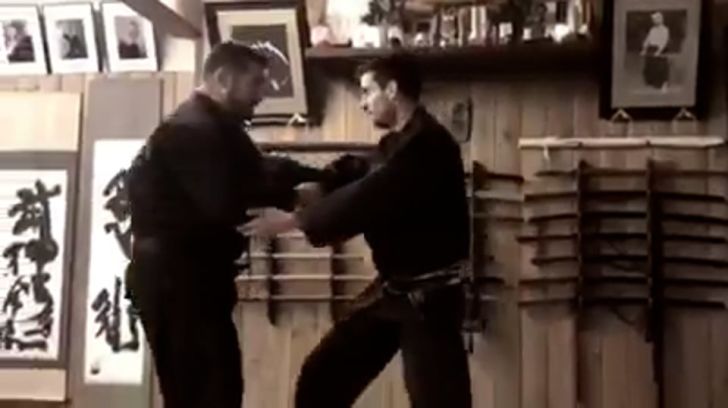Throws in taijutsu are far from simple or monotonous. Once each throwing technique is mastered individually, the next step is to combine them, one by one. As I’ve mentioned before, it’s crucial to understand and train these techniques as a flowing sequence. This concept is also integrated into randori (free sparring).
When people think of throwing techniques, they often picture a smaller person skillfully controlling a larger opponent, throwing them with style and elegance. However, in a real combat situation, it’s not a performance. Sometimes, even a small pebble can make an opponent stumble. Without developing this practical understanding of throws, it’s impossible to master the essence of the so-called “throwing in the void.”
Unlike judo or aikido, taijutsu includes countless techniques that allow you to let the opponent think they have thrown you, and at the moment they let down their guard in victory, you can catch them with a counter-throw or an atemi (strike) that will bring them down. This is one of the defining characteristics of taijutsu.
In judo, practitioners often showcase their "favorite techniques," which is acceptable in the context of sports, where the outcome is winning, losing, or drawing. However, for a heihō (military strategy) practitioner in the Warring States era, revealing a preferred technique could turn it into a weapon of their own downfall, and thus, it was rarely spoken about openly. In life-or-death combat, where the only outcomes are survival or demise, it’s better not to have a “favorite technique.”
Lately, I teach my disciples who have been training for over twenty years that, if a favorite technique is seen as a strength, it’s better not to think about one's own strengths. Rather, those who are aware of their weaknesses have a more promising future. As a result, I tend to focus on pointing out their weaknesses. Once weaknesses are eliminated, only strengths remain, and if one continues consistently in the bufū (martial spirit or style), they will not take pride in their strengths. Inevitably, their movements will become free of waste, and their strengths will be reduced to zero. It is essential to value this “zero sense.”
Excerpt written by soke Masaaki Hatsumi in his book Togakure Ryu Ninpo Taijutsu.
体術の投げは単調ではない。体術の一つ一つの投げ技を会得したところで、次に一つ一つの投げを組み合わしていく。前 にも言ったが、流れとして把握し、訓練することである。これは乱捕りにも含まれる。 投げる技というと、小さな男が大の男を手玉にとって、豪快にそして美的に投げとばす、というイメージを誰もが要求す るが、実戦の場合はお芝居ではないので、火関も小石につまずいて倒れる、そんな感覚から投げの発想術を生まなかったな らば、そういった空気投げの極意は会得できるものではない。 また柔道、合気道と違って、体術は、敵に投げさせておいて、敵が勝ったと気をゆるめた瞬間、相手の逆を捕ったり、当 てを入れて倒す技が無数にある。これも特徴の一つてある。 それから柔道でいう得意技についててあるが、柔道では得意技を発表する。スポーツとしては勝ちと負け、引き分けの世 界であるからそれでもよいが、戦国の世に生きる兵法者にとっては、得意技などということを話すと、その得意技が死を呼 ぶ技に変転するから容易に口にしない。勝負というより、生死しかない格闘技の判定には、得意技というものはもたないほ うがよいのである。 私が近ごろ、二十数年修業している弟子たちに教えることは、得意技が長所というならば、自分の長所などということはげ 考えないほうがよいということである。むしろ短所を知るもののほうに未来がある。それで短所ばかり突くことになる。短投 所がなくなれば長所だけになり、武風一貫していれば、自分の長所を得意がらなくなる。必然的に無駄のない動きになり、 長所がゼロになるわけてある。このゼロ感覚を大事にすることが肝要である。
The following videos are small examples of some of the throwing and knocking techniques studied in Taijutsu.



